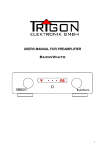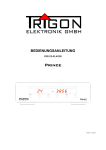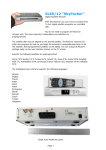Download Operating instructions TRE-50M
Transcript
Operating instructions For MONO OUTPUT STAGE TRETRE-50M 1 Preface Short description The output stage TRE-50M is a HiFi achievement amplifier for use in the home. The output stage is constructed in mono technology, i.e. for a stereo application are needed at least two devices. The advantage over a power amplifier in stereo technology is that the output stages can be set up close to the speaker and thus avoid long, expensive and loss-making speaker cables. Furthermore results an unsurpassable channel separation, which gains substantilly a spatial projection of the music.On principle each output stage has of course their own power pack. Influences by a common use of the power pack are therefore impossible. The 300VA strong power transformer and the more than 40000µF electrical capacity makes together sufficient energy available to supply the output stage always in the intended capacity range with electricity and a stable voltage. The output stage has two entrances, which can be selected over a push-button on the back of the device. Thereby is one entrance in asymmetrical technology (UNBAL) and the other entrance in symmetrical technology (BAL) implemented. Per a 3.5mm input jack the output stage can be activated remotely (AUTO) by a control voltage (approx. 4-10V DC). This function is also selectable over a push button attached on the back of the device. The digital voltmeter on the front informs constantly about the actual level of the mains voltage. This function can be switched on and off over a push-button on the back of the output stage, too. Useful is also the over-regulation announcement (PEAK), which calls your attention to the fact that the output stage has arrived to its power limit and that a further increase of the volume will lead to substantial distortions, this can harm your the output stage and your speaker, too. Start-up Please arrange the output stages close to your speakers if it’s possible. Avoid direct insolation or other heat sources in direct proximity of the output stages. The output stages may be switched on only if all interwirings are manufactured. Make sure that there is no short-circuit in the speakers conductor. To avoid possible clicks of the preamplifier, you have to switch on at first always the preamplifier and then the output stages. And to switches off in the reverse order, i.e. you have to switch off at first the output stages and then the preamplifier. 2 But it’s easier and safer if you use the automatic function (nearer information under point 4, 10, 16) The display on the front side 1 2 3 4 5 6 1. Three-figure digital voltmeter This voltmeter indicates you the actual level of the mains voltage resting in the net entrance socket. It can be switched on and/or off with the key 12 on the back of the output stage. This display has an accuracy of approx.. 2%, i.e., fluctuations in the last place around a digit are normal. This display is usefull for the qualitative estimation of fluctuations of the mains voltages. You will soon find out at which times of day this display stays relative constant, i.e. the mains voltage is stable and sound falsifications by varying mains voltage is smallest. 2. LED display UNBAL This display lights up, if you have selected the asymmetrical entrance (13) with the key 11. 3. LED display BAL This display lights up, if you have selected the symmetrical entrance (14) with the key 11. Presupposed, your preamplifier has a symmetrical exit, should this entrance be used whenever you use longer cables between preamplifiers and output stage. Thus are external voltages, which can occur on a long cable run, suppressed effectively. Note: Usually a called 6dB level stroke would arose at the use of this entrance. To avoid a level jump after switching to the asymmetrical entrance, we have asimilated the reinforcement of the XLR entrance with the reinforcement of the Cinch entrance. 3 4. LED display AUTO ONE This display lights up, if you have switched on the auto mode with the key 10. Now the output stage automatically switches itself on, as soon as a control voltage of 4 – 10 V is putting on over the socket 16. You will appreciate this practical function soon, because now you haven’t to activate each output stage separate for switching the output stages on and/or off. 5. LED display PROTECT This display flashes, if dangerous DC voltage at the speaker exit were detected by integrated protection electronics. If this display flashes, you should switch off the output stage and after one minute you restart it. But if the display flashes admittedly longer than a half minute, then a defect is present and you must bring the output stage to the service. Please have attention that this display flashes every time for approx. 15 seconds after switching on, until all supply voltages and operating points have adjusted themselves optimally. Afterwards the protect LED expired and the speaker relay is switched on. 6. LED display PEAK. Through strong dynamic jumps in the music it can come at times, depending from the adjusted volume, to an lighting up of the PEAK-LED, but this is however normal. Only if the display lights up more frequent, the volume at the preamplifier have to be reduced, because now the power limit is reached. Reduce a little bit the volume at the preamplifier, cause in the case of an over-regulation the tops of the music signal become „amputated“. The consequence is that strong distortions arises, whereby the high-pitched tones of the attached speaker can be damaged. Usually an over-regulation is good hearable, so that these are fast noticed. Please have a look at the PEAK-display from time to time to avoid a damage of your set if there are large hearing volumes. 4 The connections and controls on the back 8 9 10 11 12 89 7 13 14 16 300 15 7. Net socket with fuse Here the provided high-quality mains cable of the type TRIGON VOLT is put in. Should there is the case that the fuse burned through, the mains cable has to be pulled from the socket (and the wall socket). Now the safeguard subject can be opened with a small screwdriver and a new fuse of same type can be used. But if the fuse burns through immediately after switching on again, then the output stage has to be send to the service. Note: The name “fuse” is a bit confusing, because the fuse burns only through usually if an error and/or a defect in the device arises, i.e. the fuse isn’t in this case for the security of the amplifier, but rather for the avoidance of fire damage. Notice: The sequence is - at first the defect arises in the output stage and that’s why the fuse burns through. Without an fuse a defective device would be supplied further with electricity and damaged construction units, from which the energy is not extracted, can catch fire fast. Please replace burned through fuses only by fuses of same type!!! 8. Power switch. This switch is the backbone network switch. If the output stage is not switched in the auto mode (tracer 10), the output stage immediately switches on after activating. If the output stage is in the auto mode (LED AUTO shines), the output stage switches only after connecting the REMOTE control voltage. 5 9. Speaker exit The speaker is attached to these clamps. Please make sure that the speaker doesn’t fall below a minimum impedance of 2 Ohm. Make also sure that there is no short-circuit at this socket no, so that the output stage doesn’t take a damage. 10. Key AUTO With this key the automatic power up mode will be switched on and/or off. The LED 4 on the front signals the auto mode. 11. Key BAL/UNBAL With this key the symmetrical or asymmetrical entrance will be selected. The display LED's 2 and 3 indicates each selected channel. 12. Key Display With this key the digital mains voltage voltmeter can be switched on and/or off. 13. Cinch socket UNBAL INPUT To this socket the asymmetrical exit of the preamplifier can be attached. 14. Cinch socket PRE-OUT INV ( Has no function.) 15. XLR – Input jack BAL INPUT To this socket the symmetrical exit of the preamplifier can be attached. 6 16. REMOTE 10V DC To this 3.5mm input jack the control voltage of 4-10V DC voltage (DC) will be attached. If your preamplifier has a REMOTE exit, you can use the automatic start-up function. It is like that, that if the preamplifier is switched on, a control voltage of approx. 10V DC always rests against the remote sockets, which can be used to switch on the output stages at the same time. Therefore increases this function substantially the ease of use, because you haven’t switched on each output stage individually. Note: To avoid the so-called humming loops, you have to use only one wire for the setting up of a control line and connect the contacts only at the cone point of the 3.5mm input jack. The return is set up already over the signal lines (Cinch and/or XLR). The control cable hasn’t to be very thick, because there is just a very low electricity flowing. It’s enough if you take a strand wire of the strength 0,25 square millimetres. An influence of the audio signal by the common use of the earth conductor is not given. Therefore are sound influences not to be feared. 7 Technical data. Power output : 250 watt at 4 ohm, 135 watt at 8 ohm. Entrances/input impedance : 1x Cinch/47 kOhm, 1x XLR/47 kOhm. Entrance sensitivity : 1,2 Veff. Distortion factor (THD + N) : < 0.03%. Frequency response : 0,5 Hz – 200kHz -3dB. Noise potential unbal : 10µV (A-weighted) 14µV (unvalued). bal : 15µV (A-weighted) 22µV (unvalued). Distance of separate source voltage : -103 dB related to 1 watt at 4 ohm. Distance of weighted noise voltage : -106 dB related to 1 watt at 4 ohm. Weight : 10.1 Kg Dimensions : 300 x 89 x 390 mm (b x h x t). Subject to change. Production and construction: Trigon Elektronik GmbH Crumbacher Str. 60 D-34277 Fuldabrück Germany Tel.: +49 (0) 561 - 20753880 FAX:+49 (0) 561 – 20753888 e-mail: [email protected] web: www.trigon-audio.de 8















